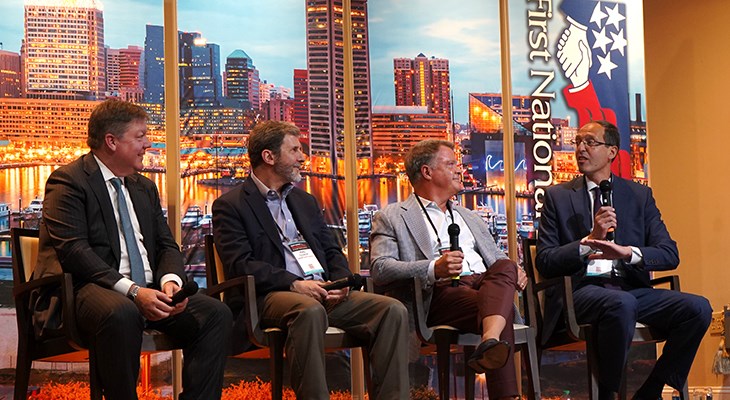When the pandemic hit, Richard McGee, Jr., president and CEO of Abacus Corp., says ecommerce went crazy.
"I told everybody, 'Buckle up the seatbelts, were on for a ride," he said during the kickoff session of this year's Baltimore Smart Business Dealmakers Conference.
Some of his staffing business's large clients, because of this massive increase in demand for goods to be shipped, were requesting double the number of people to work their distribution centers across multiple sates. At the same time, the per-hour wage was increasing, something he says he has never seen before. And despite the idea that wages might settle down at some point, they really didn't.
"The wages are still, post-pandemic, they haven't gone down at all," McGee says. "Then, when the government turned the spigot on, that was a two-edged sword for us. They were paying people to stay home and I needed these people to work for me. But at the other hand, they were putting money in people's pockets. I've never seen anything like it. Nobody saved any money. They were buying Peloton, Louis Vuitton purses, they were falling in love. I mean it was wild what was going on and we'd never seen anything like it in the past."
For Philip Tulkoff, president of Tulkoff Food Products Inc., labor has become challenging since the pandemic.
"After COVID, I'm pretty sure that three quarters of the population has lost their mind," Tulkoff says. "I have not seen the crazy stuff that we see now anytime prior in my lifetime. I've been working since 1983 in the business world, and I never saw people not show up for interviews; accept the job, sign it, take the drug test and then never show up or call you back. People leave at lunchtime — disappear — never come back, won't call you back and tell you what's going on. Now look, that's not the majority. But there's this 10, 15, 20 percent that just kind of cycles through that. We never used to have that kind of stuff before."
To counter that, he says the company continues to automate to try to reduce the amount of labor, focusing on areas where there's greater risk of injury or the work is monotonous — pallet stacking, for instance — as they are jobs that people tend not to want to do anyway.
On the white collar side he says they have very little turnover, but the demands of job seekers are "crazy."
"The salaries are out of sight, much more than I even expected when we started talking to people that were looking for jobs," he says. "And then demands for 100 percent work at home. We do a little bit of that. But in a factory, you got to be there to run the machines, you can't do a lot of stuff from home. So, things have changed. It's been difficult, but we're still managing to get by."
Ahmed El Nokali, Head of Capital Markets/Chief Economist at First National Bank, however, says he's encouraged by the labor market.
"There's a couple positive trends. One, when we first heard the term 'soft landing,' I think most of us sort of laughed," he says. "The recipe for a soft landing was, you do not have to destroy jobs, you have to destroy job openings. If there's less mobility for people, they were going to command a lower salary. At the peak, what we saw was, there were two jobs open for every one unemployed person. That's astronomical. That blows my mind. We've seen that number whittle down with job openings being destroyed, but people still maintaining their jobs. So, at the moment, there is now 1.36 job openings for every unemployed. So, you're trending in the right direction. It's taking a little bit of froth out of the labor market. We're starting to see labor force participation tick up, both on the men and the women's side. A lot of it is attributed to work from home. Most companies, they have mixed views on it, but it has brought more people back into the labor force. And the more people who are to work, obviously the more froth comes out in the labor market."
He says he's also seeing a decline in the number of employees who are actively quitting their jobs.
"Most times when people quit to get another job, they are commanding a higher salary, which then changes the benchmark," El Nokali says. "That quit rate is now below where it was prior to the pandemic. So, these things make me somewhat encouraged that the outlook for the labor market is normalizing."




